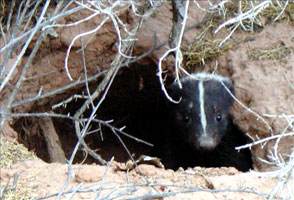|
Skunk
Skunks look like cats. Don't get close to a skunk. They can smell bad! |
|||||||||
|
Skunks are sometimes called polecats. Size: Striped Skunks are the largest. They are about size of a cat. Spotted skunks are smaller.
|
 |
||||||||
|
|
Characteristics: Most skunks are bright black and white. They are easy to see. Most enemies stay away from skunks. They don't like the bad smell. Most skunks two long stripes. |
||||||||
|
Striped
Skunk
|
|||||||||
|
Skunks are busy at night. Skunks are active all year. Food: Skunks eat at night. They eat bugs, frogs, bird eggs, and small animals. They also eat fruits and berries. They are not picky eaters. |
 |
||||||||
|
Habitat: Skunks live in many places. They like woods, prairies, and even towns. They can live in wet and dry places. Skunks can dig their own den. They often live in homes other animals leave behind. They will also nest under houses. |
 |
||||||||
|
Reproduction: Four to seven babies are born in the spring. They are called kits. Young skunks stay inside for six weeks. Then, their mother teaches them to hunt. Locomotion: Skunks walk slowly. They don't usually worry about enemies. Den Habits: Male skunks live alone. Mothers live with their babies. Range: Skunks are found in most of North America. |
|||||||||
 |
Self-defense: Skunks can spray from a hole in their rear end. This spray has a bad odor. It can hurt your eyes. Even skunks dislike the smell. |
||||||||
|
Predators: Some enemies take young skunks. Great Horned Owls fly down and catch them. Coyotes and dogs are also enemies. The biggest enemies are humans. Many skunks are run over by cars. At one time, some skunks were hunted for fur. More Information
| Main Page | Basics | More Detail | In Depth | WebQuest | | Living Things | NatureScapes | Note:
All photographs were taken with a digital camera in Courthouse Wash,
Arches National Park, Utah. |
|||||||||
